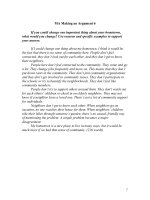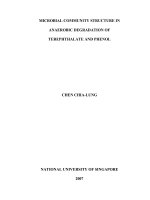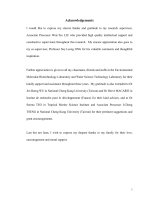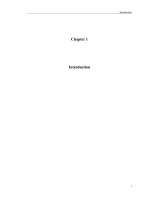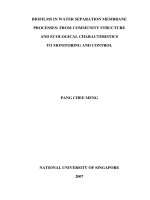06 community structure
Bạn đang xem bản rút gọn của tài liệu. Xem và tải ngay bản đầy đủ của tài liệu tại đây (45.01 MB, 58 trang )
CS224W: Analysis of Networks
Jure Leskovec, Stanford University
Communities
Roles
RolX
Henderson, et al., KDD 2012
Fast Modularity
Clauset, et al., Phys. Rev. E 2004
Nodes with different structural roles
(connector node, bridge node, etc.)
10/11/18
Jure Leskovec, Stanford CS224W: Analysis of Networks
Nodes belonging to the same
cluster/community
2
Plan for Today:
¡
Structural role discovery in networks
¡
Community detection via Modularity
optimization
10/11/18
Jure Leskovec, Stanford CS224W: Analysis of Networks
3
¡
Roles are “functions” of nodes in a network:
§ Roles of species in ecosystems
§ Roles of individuals in companies
¡
Roles are measured by structural behaviors:
10/11/18
§ Centers of stars
§ Members of cliques
§ Peripheral nodes, etc.
Jure Leskovec, Stanford CS224W: Analysis of Networks
5
centers of stars
members of cliques
peripheral nodes
Network Science
Co-authorship network
[Newman 2006]
10/11/18
Jure Leskovec, Stanford CS224W: Analysis of Networks
6
¡
Role: A collection of nodes which have similar
positions in a network:
¡
Roles are based on the similarity of ties among subsets of
nodes
§ Different from community (or cohesive subgroup)
§ Group is formed based on adjacency, proximity or
reachability
§ This is typically adopted in current data mining
Nodes with the same role need not be in direct,
or even indirect interaction with each other
10/11/18
Jure Leskovec, Stanford CS224W: Analysis of Networks
7
¡
Roles:
§ A group of nodes with similar structural properties
¡
Communities:
§ A group of nodes that are well-connected to each other
¡
Roles and communities are complementary
¡
Consider the social network of a CS Dept:
§ Roles: Faculty, Staff, Students
§ Communities: AI Lab, Info Lab, Theory Lab
10/11/18
Jure Leskovec, Stanford CS224W: Analysis of Networks
8
¡
Structural equivalence: Nodes ! and " are
structurally equivalent if they have the same
relationships to all other nodes [Lorrain & White
1971]
§ Structurally equivalent nodes are likely to be similar in
other ways – i.e., friendships in social networks
a
10/11/18
b
c
u
v
d
e
Jure Leskovec, Stanford CS224W: Analysis of Networks
9
¡
¡
Nodes ! and " are structurally equivalent:
§ For all the other nodes #, node ! has tie to # iff node "
has tie to #
Example:
Adjacency matrix
2
1
1 2 3 4 5
1 - 0 1 1 0
4
3
2 0 - 1 1 0
3 0 0 - 0 1
4 0 0 0 - 1
5
¡
5 0 0 0 0 -
E.g., nodes 3 and 4 are structurally equivalent
10/11/18
Jure Leskovec, Stanford CS224W: Analysis of Networks
48
Task
Example Application
Role query
Identify individuals with similar behavior to a known
target
Role outliers
Identify individuals with unusual behavior
Role dynamics
Identify unusual changes in behavior
Identity resolution
Identify/de-anonymize, individuals in a new network
Role transfer
Use knowledge of one network to make predictions in
another
Network comparison
Compute similarity of networks, determine
compatibility for knowledge transfer
10/11/18
Jure Leskovec, Stanford CS224W: Analysis of Networks
12
¡
RolX: Automatic discovery
of nodes’ structural roles in
networks
[Henderson, et al. 2011b]
Role Discovery
Input
Output
§ Unsupervised learning approach
§ No prior knowledge required
§ Assigns a mixed-membership of
roles to each node
§ Scales linearly in #(edges)
10/11/18
Jure Leskovec, Stanford CS224W: Analysis of Networks
üAutomated discovery
Behavioral roles
üRoles
ü generalize
13
Input
Node × Node
Adjacency Matrix
Recursive
Feature
Extraction
Node × Feature
Matrix
Example: degree, mean
weight, # of edges in
ego-network, mean
clustering coefficient of
neighbors, etc.
Role
Extraction
Role × Feature
Matrix
Node × Role
Matrix
Output
10/11/18
Jure Leskovec, Stanford CS224W: Analysis of Networks
14
¡
Recursive feature extraction [Henderson, et al. 2011a] turns
network connectivity into structural features
Regional
Neighborhood
Recursive
feature
extraction
ReFeX
¡
¡
Nodes
Local
1411#
1410#
338#
339#
1415#
941#
1414#
942#
1413#
1412#
940#
1419#
945#
332#
1418#
946#
333#
1417#
943#
330#
1416#
944#
331#
949#
336#
337#
947#
334#
948#
335#
531#
0#
0#
0#
1#
0#
0#
0#
0#
0#
0#
0#
0#
0#
0#
0#
0#
0#
0#
0#
1#
0#
0#
0#
0#
0#
1#
1#
0#
0#
0#
1#
1#
1#
0#
0#
1#
0#
1#
0#
1#
0#
0#
0#
1#
0#
0#
1#
0#
1#
0#
3#
1#
1#
3#
0#
0#
1#
0#
0#
0#
0#
0#
2#
1#
0#
0#
1#
0#
1#
0#
1#
0#
1#
1#
4#
0#
1#
1#
0#
1#
0#
2#
1#
4#
2#
0#
0#
1#
0#
0#
0#
0#
0#
1#
1#
0#
0#
2#
0#
1#
0#
1#
0#
0#
0#
3#
0#
0#
0#
0#
1#
1#
0#
1#
2#
1#
0#
0#
0#
0#
1#
0#
1#
0#
Egonet
0#
0#
1#
2#
0#
1#
0#
1#
0#
0#
0#
0#
0#
1#
0#
0#
1#
0#
0#
1#
1#
0#
0#
2#
2#
0#
2#
1#
0#
0#
1#
0#
1#
0#
0#
1#
0#
1#
0#
1#
0#
0#
1#
0#
0#
0#
1#
0#
2#
0#
2#
2#
0#
1#
0#
0#
1#
0#
0#
1#
0#
0#
0#
0#
1#
1#
0#
1#
0#
0#
1#
0#
0#
0#
0#
1#
0#
0#
1#
0#
0#
2#
0#
0#
0#
0#
0#
2#
1#
0#
0#
0#
2#
1#
0#
0#
0#
0#
0#
0#
0#
0#
1#
1#
1#
0#
0#
1#
1#
0#
0#
0#
0#
0#
0#
0#
1#
1#
0#
0#
0#
1#
0#
0#
1#
1#
0#
0#
0#
0#
0#
0#
0#
2#
0#
1#
2#
0#
0#
0#
0#
1#
0#
2#
1#
2#
2#
0#
1#
1#
0#
0#
1#
0#
0#
Recursive
0#
0#
1#
2#
0#
1#
0#
0#
0#
0#
0#
0#
0#
1#
0#
0#
1#
0#
0#
2#
0#
0#
0#
1#
1#
1#
2#
0#
0#
0#
2#
1#
1#
0#
0#
0#
0#
0#
0#
0#
1#
0#
1#
1#
0#
0#
0#
0#
1#
0#
2#
1#
1#
2#
0#
1#
1#
0#
0#
1#
0#
0#
0#
0#
0#
1#
0#
0#
0#
0#
0#
1#
1#
1#
0#
0#
1#
1#
0#
0#
0#
0#
0#
0#
0#
1#
1#
0#
1#
0#
1#
0#
0#
0#
1#
0#
0#
1#
0#
1#
0#
1#
0#
1#
1#
0#
0#
2#
4#
0#
1#
0#
3#
1#
0#
2#
0#
0#
1#
0#
0#
1#
0#
0#
1#
0#
1#
1#
1#
0#
1#
0#
1#
0#
0#
0#
2#
0#
0#
0#
0#
0#
0#
1#
0#
2#
0#
0#
0#
1#
1#
0#
0#
0#
2#
1#
1#
0#
0#
1#
0#
0#
0#
0#
1#
1#
1#
1#
0#
1#
1#
0#
1#
1#
0#
0#
0#
1#
0#
0#
1#
0#
0#
1#
1#
0#
2#
1#
0#
0#
1#
0#
1#
0#
1#
2#
1#
1#
3#
0#
0#
1#
0#
1#
0#
2#
1#
3#
2#
0#
1#
1#
0#
0#
1#
0#
0#
2#
1#
0#
0#
1#
0#
1#
0#
1#
0#
1#
1#
1#
0#
1#
2#
0#
1#
0#
5#
1#
1#
5#
0#
0#
1#
0#
0#
0#
0#
0#
Neighborhood features: What is a node’s connectivity pattern?
Recursive features: To what kinds of nodes is a node connected?
10/11/18
Jure Leskovec, Stanford CS224W: Analysis of Networks
15
¡
Idea: Aggregate features of a node and use them to
generate new recursive features
¡
Base set of a node’s neighborhood features:
§ Local features: All measures of the node degree:
§ If network is directed, include in- and out-degree, total degree
§ If network is weighted, include weighted feature versions
§ Egonetwork features: Computed on the node’s egonet:
§ Egonet includes the node, its neighbors, and any edges in the
induced subgraph on these nodes
§ #(within-egonet edges),
#(edges entering/leaving egonet)
10/11/18
Jure Leskovec, Stanford CS224W: Analysis of Networks
Egonet for red node
16
¡
¡
Start with the base set of node features
Use the set of current node features to generate
additional features:
§ Two types of aggregate functions: means and sums
§ E.g., mean value of “unweighted degree” feature among all
neighbors of a node
§ Compute means and sums over all current features, including other
recursive features
The number of possible recursive
features grows exponentially with
each recursive iteration:
§ Reduce the number of features using a
pruning technique:
10/11/18
1411#
1410#
338#
339#
1415#
941#
1414#
942#
1413#
1412#
940#
1419#
945#
332#
1418#
946#
333#
1417#
943#
330#
1416#
944#
331#
949#
336#
337#
947#
334#
948#
335#
531#
Nodes
¡
§ Repeat
0#
0#
0#
1#
0#
0#
0#
0#
0#
0#
0#
0#
0#
0#
0#
0#
0#
0#
0#
1#
0#
0#
0#
0#
0#
1#
1#
0#
0#
0#
1#
1#
1#
0#
0#
1#
0#
1#
0#
1#
0#
0#
0#
1#
0#
0#
1#
0#
1#
0#
3#
1#
1#
3#
0#
0#
1#
0#
0#
0#
0#
0#
2#
1#
0#
0#
1#
0#
1#
0#
1#
0#
1#
1#
4#
0#
1#
1#
0#
1#
0#
2#
1#
4#
2#
0#
0#
1#
0#
0#
0#
0#
0#
1#
1#
0#
0#
2#
0#
1#
0#
1#
0#
0#
0#
3#
0#
0#
0#
0#
1#
1#
0#
1#
2#
1#
0#
0#
0#
0#
1#
0#
1#
0#
0#
0#
1#
2#
0#
1#
0#
1#
0#
0#
0#
0#
0#
1#
0#
0#
1#
0#
0#
1#
1#
0#
0#
2#
2#
0#
2#
1#
0#
0#
1#
Features
0#
1#
0#
0#
1#
0#
1#
0#
1#
0#
0#
1#
0#
0#
0#
1#
0#
2#
0#
2#
2#
0#
1#
0#
0#
1#
0#
0#
1#
0#
0#
0#
0#
1#
1#
0#
1#
0#
0#
1#
0#
0#
0#
0#
1#
0#
0#
1#
0#
0#
2#
0#
0#
0#
0#
0#
2#
1#
0#
0#
0#
2#
1#
0#
0#
0#
0#
0#
0#
0#
0#
1#
1#
1#
0#
0#
1#
1#
0#
0#
0#
0#
0#
0#
0#
1#
1#
0#
0#
0#
1#
0#
0#
1#
1#
0#
0#
0#
0#
0#
0#
0#
2#
0#
1#
2#
0#
0#
0#
0#
1#
0#
2#
1#
2#
2#
0#
1#
1#
0#
0#
1#
0#
0#
0#
0#
1#
2#
0#
1#
0#
0#
0#
0#
0#
0#
0#
1#
0#
0#
1#
0#
0#
2#
0#
0#
0#
1#
1#
1#
2#
0#
0#
0#
2#
1#
1#
0#
0#
0#
0#
0#
0#
0#
1#
0#
1#
1#
0#
0#
0#
0#
1#
0#
2#
1#
1#
2#
0#
1#
1#
0#
0#
1#
0#
0#
Output
§ Look for pairs of features that are highly correlated
§ Eliminate one of the features whenever two features are correlated
above a user-defined threshold
Jure Leskovec, Stanford CS224W: Analysis of Networks
0#
0#
0#
1#
0#
0#
0#
0#
0#
1#
1#
1#
0#
0#
1#
1#
0#
0#
0#
0#
0#
0#
0#
1#
1#
0#
1#
0#
1#
0#
0#
0#
1#
0#
0#
1#
0#
1#
0#
1#
0#
1#
1#
0#
0#
2#
4#
0#
1#
0#
3#
1#
0#
2#
0#
0#
1#
0#
0#
1#
0#
0#
1#
0#
1#
1#
1#
0#
1#
0#
1#
0#
0#
0#
2#
0#
0#
0#
0#
0#
0#
1#
0#
2#
0#
0#
0#
1#
1#
0#
0#
0#
2#
1#
1#
0#
0#
1#
0#
0#
0#
0#
1#
1#
1#
1#
0#
1#
1#
0#
1#
1#
0#
0#
0#
1#
0#
0#
1#
0#
0#
1#
1#
0#
17
2#
1#
0#
0#
1#
0#
1#
0#
1#
2#
1#
1#
3#
0#
0#
1#
0#
1#
0#
2#
1#
3#
2#
0#
1#
1#
0#
0#
1#
0#
0#
2#
1#
0#
0#
1#
0#
1#
0#
1#
0#
1#
1#
1#
0#
1#
2#
0#
1#
0#
5#
1#
1#
5#
0#
0#
1#
0#
0#
0#
0#
0#
Input
Output
10/11/18
Jure Leskovec, Stanford CS224W: Analysis of Networks
Nodes
Recursively
extract features
1411#
1410#
338#
339#
1415#
941#
1414#
942#
1413#
1412#
940#
1419#
945#
332#
1418#
946#
333#
1417#
943#
330#
1416#
944#
331#
949#
336#
337#
947#
334#
948#
335#
531#
0#
0#
0#
1#
0#
0#
0#
0#
0#
0#
0#
0#
0#
0#
0#
0#
0#
0#
0#
1#
0#
0#
0#
0#
0#
1#
1#
0#
0#
0#
1#
1#
1#
0#
0#
1#
0#
1#
0#
1#
0#
0#
0#
1#
0#
0#
1#
0#
1#
0#
3#
1#
1#
3#
0#
0#
1#
0#
0#
0#
0#
0#
2#
1#
0#
0#
1#
0#
1#
0#
1#
0#
1#
1#
4#
0#
1#
1#
0#
1#
0#
2#
1#
4#
2#
0#
0#
1#
0#
0#
0#
0#
0#
1#
1#
0#
0#
2#
0#
1#
0#
1#
0#
0#
0#
3#
0#
0#
0#
0#
1#
1#
0#
1#
2#
1#
0#
0#
0#
0#
1#
0#
1#
0#
0#
0#
1#
2#
0#
1#
0#
1#
0#
0#
0#
0#
0#
1#
0#
0#
1#
0#
0#
1#
1#
0#
0#
2#
2#
0#
2#
1#
0#
0#
1#
Features
0#
1#
0#
0#
1#
0#
1#
0#
1#
0#
0#
1#
0#
0#
0#
1#
0#
2#
0#
2#
2#
0#
1#
0#
0#
1#
0#
0#
1#
0#
0#
0#
0#
1#
1#
0#
1#
0#
0#
1#
0#
0#
0#
0#
1#
0#
0#
1#
0#
0#
2#
0#
0#
0#
0#
0#
2#
1#
0#
0#
0#
2#
1#
0#
0#
0#
0#
0#
0#
0#
0#
1#
1#
1#
0#
0#
1#
1#
0#
0#
0#
0#
0#
0#
0#
1#
1#
0#
0#
0#
1#
0#
0#
1#
1#
0#
0#
0#
0#
0#
0#
0#
2#
0#
1#
2#
0#
0#
0#
0#
1#
0#
2#
1#
2#
2#
0#
1#
1#
0#
0#
1#
0#
0#
0#
0#
1#
2#
0#
1#
0#
0#
0#
0#
0#
0#
0#
1#
0#
0#
1#
0#
0#
2#
0#
0#
0#
1#
1#
1#
2#
0#
0#
0#
2#
1#
1#
0#
0#
0#
0#
0#
0#
0#
1#
0#
1#
1#
0#
0#
0#
0#
1#
0#
2#
1#
1#
2#
0#
1#
1#
0#
0#
1#
0#
0#
0#
0#
0#
1#
0#
0#
0#
0#
0#
1#
1#
1#
0#
0#
1#
1#
0#
0#
0#
0#
0#
0#
0#
1#
1#
0#
1#
0#
1#
0#
0#
0#
1#
0#
0#
1#
0#
1#
0#
1#
0#
1#
1#
0#
0#
2#
4#
0#
1#
0#
3#
1#
0#
2#
0#
0#
1#
0#
0#
1#
0#
0#
1#
0#
1#
1#
1#
0#
1#
0#
1#
0#
0#
0#
2#
0#
0#
0#
0#
0#
0#
1#
0#
2#
0#
0#
0#
1#
1#
0#
0#
0#
2#
1#
1#
0#
0#
1#
0#
0#
0#
0#
1#
1#
1#
1#
0#
1#
1#
0#
1#
1#
0#
0#
0#
1#
0#
0#
1#
0#
0#
1#
1#
0#
2#
1#
0#
0#
1#
0#
1#
0#
1#
2#
1#
1#
3#
0#
0#
1#
0#
1#
0#
2#
1#
3#
2#
0#
1#
1#
0#
0#
1#
0#
0#
2#
1#
0#
0#
1#
0#
1#
0#
1#
0#
1#
1#
1#
0#
1#
2#
0#
1#
0#
5#
1#
1#
5#
0#
0#
1#
0#
0#
0#
0#
0#
1) Can compare nodes
based on their structural
similarity
2) Can cluster nodes to
identify different
structural roles
e.g, RolX uses a clustering technique
called non-negative matrix factorization
18
¡
Task: Cluster nodes based on their structural
similarity
¡
Two networks:
§ Network science co-authorship network:
§ Nodes: Network scientists; Edges: The number of co-authored papers
§ Political books co-purchasing network:
§ Nodes: Political books on Amazon; Edges: Frequent co-purchasing of
books by the same buyers
¡
Setup: For each network:
§ Use RolX to assign each node a distribution over the
set of discovered, structural roles
§ Determine similarity between nodes by comparing
their role distributions
10/11/18
Jure Leskovec, Stanford CS224W: Analysis of Networks
19
IP traffic classes are well-separated in
role space” with as few as 3 roles. (a)
t showing the degree of membership of
P2P, and Web host in each of three roles.
density plot obtained by adding uniform
to reveal overlapping points.
(a) Role-colored Visualization of the Network
DEVICE
RolX
Baseline
in
a)
of
Time
s.
(a)
Role-colored
Visualization
of the
Networkby
DEVICE
m (a) Business
Role-colored
graph:
each node
is colored
Student
vs.
Rest
the primary
role that RolX finds
RolX
Baseline
Role affinity heat-map
(b) Role Affinity Heat Map
Figure 9: RolX e↵ectively discovers roles in the
Making sense of roles:
Network Science Co-authorship Graph. (a) Author
¡ Blue circle: Tightly knit, nodes that participate in tightly-coupled groups
network RolX discovered four roles, like the het¡ Red diamond: Bridge nodes, that
connectbridges
groups (red
of nodes
erophilous
diamond ), as well as the ho¡ Gray rectangle: Main-stream, most
of
nodes,
neither
a
a chain(b) Affinmophilous “pathy” nodesclique,
(green nor
triangle)
¡ Green triangle: Pathy, nodes that
elongated
clustersblue is low) - strong
ity belong
matrix to
(red
is high score,
homophily for roles #1 and #4.
10/11/18
Jure Leskovec, Stanford CS224W: Analysis of Networks
20
Communities
Roles
RolX
Henderson, et al., KDD 2012
10/11/18
Fast Modularity
Clauset, et al., Phys. Rev. E 2004
Jure Leskovec, Stanford CS224W: Analysis of Networks
22
¡
We often think of networks “looking”
like this:
¡
What led to such a conceptual picture?
10/11/18
Jure Leskovec, Stanford CS224W: Analysis of Networks
23
¡
How does information flow through the network?
§ What structurally distinct roles do nodes play?
§ What roles do different links (“short” vs. “long”) play?
¡
How do people find out about new jobs?
§ Mark Granovetter, part of his PhD in 1960s
§ People find the information through personal contacts
¡
But: Contacts were often acquaintances
rather than close friends
§ This is surprising: One would expect your friends to help
you out more than casual acquaintances
¡
Why is it that acquaintances are most helpful?
10/11/18
Jure Leskovec, Stanford CS224W: Analysis of Networks
24
[Granovetter ‘73]
¡
Two perspectives on friendships:
§ Structural: Friendships span different parts of the
network
§ Interpersonal: Friendship between two people is
either strong or weak
¡
Structural role: Triadic Closure
a
b
c
If two people in a
network have a friend in
common, then there is
an increased likelihood
they will become friends
themselves.
Which edge is more
likely, a-b or a-c?
10/11/18
Jure Leskovec, Stanford CS224W: Analysis of Networks
25


